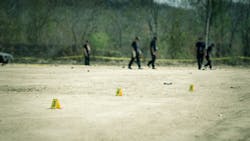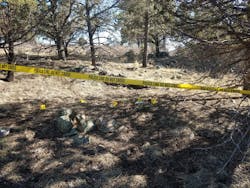The Need for Training: How and Why to Reconstruct Crime Scenes
In law enforcement, training is always necessary. Most departments have encouraged and/or required their officers to obtain a particular number of hours of training and continuing education. It is no different with crime scene investigators. When it comes to crime scene investigation training, the options are endless. You can focus on specific forensic disciplines, evidentiary protocols, or general crime scene investigation.
Why conduct crime scene reconstruction training?
The question is: Why bother with reconstruction oriented training? The reasons are many. The entire purpose of crime scene reconstruction is to recreate a crime scene for the purpose of figuring out what may have happened in order to solve a crime. When you reconstruct a crime scene, you are putting yourself, the investigator, inside of the crime scene and unfolding the events that took place for investigative purposes. It should be understood the reason for conducting reconstruction. From there you can put the pieces of the puzzle together and determine what may have happened and perhaps you can discover the significance of certain items of evidence.
For example, say you are called to a stabbing scene. There is blood spatter on three surfaces, all going in different directions. Since the stabbing was non-fatal, and can be categorized as an aggravated assault or attempted murder, you have two victims telling you two different stories. One victim claims the incident occurred as a result of self-defense. The other claims they were attacked first, unprovoked, and they did not fight back. By studying the blood spatter, you will be able to tell more often than not who is telling the truth based on directionality of the blood. Of course in this instance, blood will still have to be sent to the lab for DNA testing along with exemplars from both victims. However, after taking your crime scene photos you could go back to your department and put together a reconstruction of these events by splashing synthetic blood onto butcher paper to recreate the patterns. To solidify your theory, you would want to play out both victims’ stories in order to see who was being truthful (without using knives of course, just a paint brush for splashing). To ensure that the blood drops would appear similar, you would have to recreate the scene on the same type of surface (carpet, hard surfaces, outdoors, wood, etc.). Just be sure that the area you set up your reconstruction in is not one where you will ruin any surfaces and that you and your co-workers are safe. Keep old carpet, tile, etc. around in your training areas for this exact purpose.History of crime scene reconstruction
Reconstructing crime scenes has been around for decades. Frances Glessner Lee was considered to be a forensic scientist and studied legal medicine around the 1930s and 1940s. Lee designed dollhouses that depicted crime scenes around the New England area. Each one she designed had miniature figurines that were very detailed and recreated the crime scenes accurately. Her models or diagrams were used in actual homicide investigative training and these set a precedence for crime scene reconstruction as a whole.
How to reconstruct a scene
Reconstructing a crime scene should be done away from the actual crime scene. You never want to chance the possibility of contaminating or ruining the crime scene itself. However, you can certainly recreate the scene back at your department.
When you reconstruct a crime scene, you need to take safety into consideration first. Don’t ever put yourself or your coworkers in jeopardy. For instance, if your case involves a firearm, use a training gun in place of an actual firearm. Also, it is important to note that never use actual evidence. This again puts contamination of the evidence at risk and will compromise your case. Instead, use props as substitutions for evidence. There are other items or props that can be purchased from evidence supply companies for the purpose of training. This includes items such as synthetic blood and training guns. These are wise investments to make within your department because reconstructing crime scenes can prove helpful to investigations. By having the proper tools, you can bring the crime scene to life; your training will be much more effective and can educate your staff in the best possible way.
Setting up the scene
When you set up a crime scene reconstruction, take the time to incorporate every minute detail that you possibly can so that you have the best and closest re-enactment of the incident possible. Again, keep it safe. Give each participant a role in the reenactment and have a few others observing and taking notes. In addition, rotate roles out so that every one gets a chance to participate and observe. The entire purpose of reconstruction is to figure out what may have occurred and in any situation, not everyone thinks alike one hundred percent of the time. By allowing everyone to participate in every form of the activity, you open the door for more and more effective brainstorming and strategizing.
Not only is crime scene reconstruction used for figuring out what events took place, but also what did not. You can easily disprove someone’s faulty statement by recreating the scene. This is great for court because you can provide the jury with tangible proof of what did or did not happen. In fact, crime scene reconstruction software is a good tool to use now. Some of them allow you to upload your crime scene photos and then piece them together into an interactive scene. Others allow you to upload data and create an animated re-enactment.
Enhancing training with reconstruction
Lastly, incorporate this type of training into your department’s normal training schedule. The more training conducted of this nature the better all personnel will understand the importance of preserving a crime scene and how putting the pieces together can aid their case. Once you have an idea of how the incident may have occurred, there is a better chance it leads towards conviction.

Hilary Rodela
Hilary Rodela is currently a Surveillance Officer, a former Private Investigator, a former Crime Scene Investigator, and Evidence Technician. She worked for the Ruidoso (NM) Police Department as well as the Lubbock (TX) Police Department. She has written for several public safety publications and has extensive law enforcement and forensic training and is pursuing forensic expertise in various disciplines. Hilary is a freelance public safety writer and curriculum developer for the National Investigative Training Academy.




